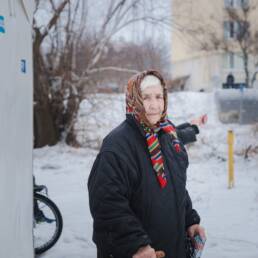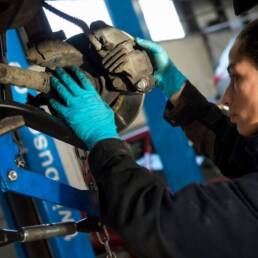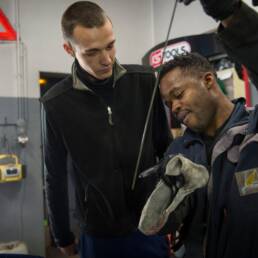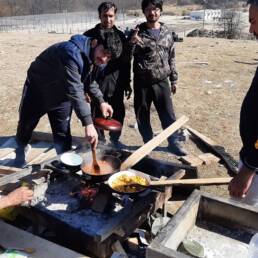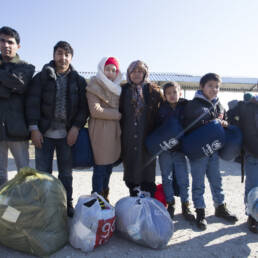Author
Leticia Lozano
Communication Officer
Caritas Europa
The most welcoming societies are those who decide to offer easy access to language and labour market integration to newcomers, said Aliyyah Ahad, associate policy analyst at the Migration Policy Institute (MPI) in Brussels.
In the European Union, where competency for migration and integration policies is in the hands of the Member States, there are wide differences between countries on how to receive newcomers.
Some of the challenges regarding language learning for migrants are that in some countries language courses for migrants and refugees are offered by volunteers, which can weaken the quality of teaching; in others migrants should pay for the courses in advance and are only reimbursed if they pass the final exams; in many, the schedule and conditions of language courses are difficult to access for women in charge of childcare.
Whether the courses are free and accessible or not makes a big difference; and also the migrants themselves need to have the time and motivation to attend the language courses,” explained Ahad.
“The most important aspects to language learning are: providing it using high quality instruction, making it affordable, and making it convenient. Those are the ingredients for success”, she added.
The benefits from learning the language of the receiving community are many: from more and better access to the labour market, to recognition of belonging from the rest of the community and a feeling of belonging for the migrants themselves.
“Language is tied to employment and to the quality of that employment; the better the language skill the most likely a newcomer will have access to good jobs or good education”, said Ahad, interviewed for the MIND project at the MPI Europe offices, a few steps from the European Commission headquarters.
The language-job trade-off
Often migrants are under pressure to get a job quickly due to reasons ranging from covering living costs and paying debts to the need to send money to family back in their country of origin. Although a swift insertion into the labour market can look good on national statistics, governments and authorities should work together to protect newcomers from getting stuck in low-quality, unsuitable or even dangerous employment.
Instead, Ahad recommends that where possible policymakers should prioritise allowing newcomers to learn the language and get their qualifications recognised in the receiving countries, rather than merely the fastest entry into employment.
The largest benefit will indeed be to the national economic growth, as newcomers are able to contribute to their potential. But it will also be visible in a better integration of newcomers and a stronger sense of community.
Gains to the GDP (Gross Domestic Product) will be the most obvious ones, as a result of increasing the productivity of the country by making use of the talents and skills that are within the territory,” she said. “Obviously if you have doctors driving taxis, which is one of the stereotypes we hear all the time, this is not the most productive use of their skills.”
The risks of this happening are particularly high nowadays due to the growth of the so-called “gig economy”. These kind of jobs, which include independent self-employment under schemes such as Uber, offer little social mobility and very limited meaningful social interactions, which are key to improving integration. Often the same applies for informal work.
And additional benefit from more and better quality labour insertion for migrants would be an improvement in the general perception of them.
“From a communications perspective, seeing high employment and high labour market participation among migrants tends to set a positive image for other citizens”, said Ahad.
Whilst designing integration initiatives related to language and employment, it is extremely important that authorities keep a long-term perspective and avoid dedicating resources to responding only to the short-term demands of the labour market.
“The question is: Are we getting people into work and training them for the jobs that exist today or are we looking at where the risk for automation or other challenges might come from? How do you train people with the skills that they might need in times of technological and economic uncertainty?”
Integration is a two-way street
An important obstacle for migrants and people with a migrant background to integrate into the labour market is discrimination. Legal frameworks should prevent discrimination from happening during the recruitment process and employment, but societal changes are also very much needed.
When we are talking about integration, often it only focuses on migrants whereas integration, as the EU describes it, is a two-way street”, explained the researcher. “At MPI we say it is even more complex. Integration is a very multifaceted and inter-directional process, so you also have to take account of the whole society, with all its members, and of what they are doing in order to integrate into the new society that is being created for everyone.”
Welcoming societies must consciously work to eliminate discrimination, now an important barrier for newcomers to find fulfilling employment.
EU vs Member States competency
Whilst migrant integration is the competency of the Member States, the EU has certainly an important role to play, explained Ahad.
One of the ways in which the EU institutions have been involved on migrant integration is by setting goals and policy related objectives for Member States. The EU has been active this way since 2004, when the Common Basic Principles on Integration were set; in 2011 with the European Agenda on Third Country Nationals; and in 2016 with the Action Plan on Integration of Third Country Nationals.
A second way is by providing funding and support with tools such as the Asylum Migration and Integration Fund (AMIF), of which 20% is earmarked for integration activities; and other tools such as the European Social Fund and Horizon 2020, which are funding research in this area or that are funding projects directly related to creating welcoming societies and integration. A third way is by conducting research on the topic such as the Eurobarometer survey in 2018 about population attitudes towards migrant integration, and the Integration Indicators, a joint report with the OECD, among others. Finally, the EU institutions are also involved in the topic through tools such as the European Web Site on Integration, which is a great repository of information, and the skills profile tool that was created in the wake of the so-called migration crisis in 2015 to help employers to integrate newcomers into the labour market.
But ultimately, migrant integration and the development of welcoming societies is a competency of the Member States and advancement in this field varies greatly within the Union and even within countries and at the community level.
Still, if there is something that the EU could do more and better to contribute to migrant integration it is precisely to support work at the local level. Although a few initiatives are dedicated to this, such as the Urban Innovation Actions, the Urban Agenda and the Urban Academy, there is room for improvement, according to Ahad.
Another important step would be for the EU to work more directly with migrant-led organisations, which usually work on a volunteer basis and do not attend or are even aware of the large EU conferences on the topic, often taking place in Brussels.
I think the EU could better reach out to these kinds of organisations to avoid having a room full of people talking about migrants, which is what often happens now, as opposed to migrants being able to represent their own views around the table,” Ahad concluded.



